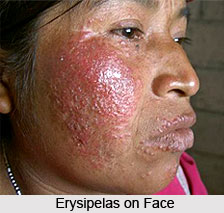 Erysipelas is a disease of the skin and subcutaneous tissue. It is a disease characterized by diffused inflammation of the skin or of the subcutaneous cellular tissue, attended with fever. When the disease is in a mild form, the skin becomes red, hard, and also thick. Small cysts appear on it. The redness tends to spread to the neighbouring areas of the skin and the whole body may be involved in the inflammatory process. If the subcutaneous tissue is involved, pus may sometimes form under the skin.
Erysipelas is a disease of the skin and subcutaneous tissue. It is a disease characterized by diffused inflammation of the skin or of the subcutaneous cellular tissue, attended with fever. When the disease is in a mild form, the skin becomes red, hard, and also thick. Small cysts appear on it. The redness tends to spread to the neighbouring areas of the skin and the whole body may be involved in the inflammatory process. If the subcutaneous tissue is involved, pus may sometimes form under the skin.
Causes and Symptoms: Erysipelas of the face begins with symptoms of general illness. The patient feels languid, drowsy, and sick. There is frequent shivering, and later, fever also comes. The temperature may rise to 40°C or 40.6°C. Inflammation may appear on the face, beginning with the tip of the nose. If the inflammation is not controlled in time and spreads to the throat, the windpipe may become involved, leading to fatal results. If the inflammation attacks the membranes of the brain, the result is almost always fatal. Ayurveda believes erysipelas to be the result of the vitiation of all the three doshas. It is categorized according to the dosha involved. It is of seven types, but Sushruta has mentioned five varieties. Three of them born of the vitiation of any of the three doshas, one born of more than one dosha, and another caused by injury.
The various varieties of erysipelas and its symptoms differ according to the dosha involved, but most of the symptoms common to all the varieties. And these can be mentioned as inflammation of the skin and the cellular tissues underneath the epidermis, fever and other symptoms present in a fever. When the disease is in a mild form, there is only redness of the skin appeared in the patient.
Home Remedies: The inflamed skin should be treated with Dashangalepa to which cow`s ghee should be added. It should be rubbed gently over the affected part of the skin.
The patient may be bled for quick results, but that should be done under the supervision of an expert in the techniques of bloodletting. Any excessive loss of blood could pose a danger to the life of the patient.
Diet and Other Regimen: The dietary regimen is the same as in the case of other fevers.
The patient must avoid a cold bath and exposure to cold wind as that is likely to aggravate his condition.




